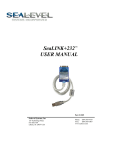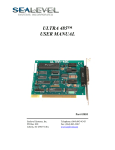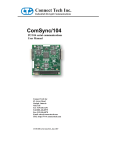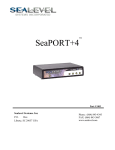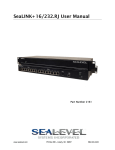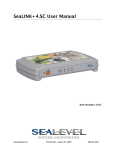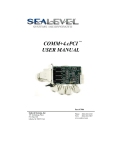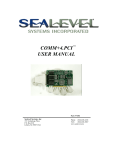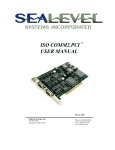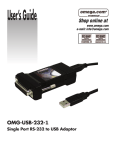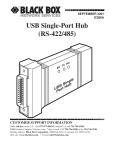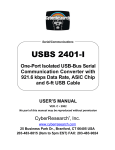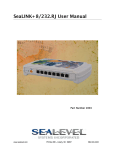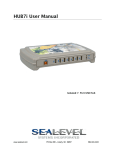Download SeaLINK+485 USER MANUAL
Transcript
TM SeaLINK+485 USER MANUAL Part # 2102 Sealevel Systems, Inc 155 Technology Place P.O. Box 830 Liberty, SC 29657 USA Phone: (864) 843-4343 FAX: (864) 843-3067 www.sealevel.com Contents INTRODUCTION ........................................................................ 1 OVERVIEW ...........................................................................................1 WHAT’S INCLUDED..............................................................................1 INSTALLATION.......................................................................... 2 OPERATING SYSTEM INSTALLATION ....................................................2 SYSTEM INSTALLATION .......................................................................2 CONFIGURATION ...................................................................... 6 ELECTRICAL INTERFACE SELECTION .....................................................6 SWITCH EXAMPLES .............................................................................7 TECHNICAL DESCRIPTION ....................................................... 8 FEATURES ............................................................................................8 CONNECTOR P IN ASSIGNMENTS (DB25 MALE) ..................................8 SPECIFICATIONS ....................................................................... 9 ENVIRONMENTAL SPECIFICATIONS.......................................................9 MANUFACTURING................................................................................9 P OWER CONSUMPTION ........................................................................9 MEAN TIME BETWEEN FAILURES (MTBF) ..........................................9 P HYSICAL DIMENSIONS........................................................................9 APPENDIX A - TROUBLESHOOTING ....................................... 10 APPENDIX B - HOW TO GET ASSISTANCE ............................. 11 APPENDIX C - ELECTRICAL INTERFACE ................................ 12 RS-530.............................................................................................12 RS-422.............................................................................................12 RS-485.............................................................................................13 APPENDIX D - ASYNCHRONOUS COMMUNICATIONS ............ 14 APPENDIX E - COMPLIANCE NOTICES ................................... 15 FEDERAL COMMUNICATIONS COMMISSION STATEMENT ...................15 EMC DIRECTIVE STATEMENT ...........................................................15 WARRANTY ............................................................................ 16 Figures: Figure 1- RS-530/422 4 Wire 485 (Default) .................................................... 7 Figure 2 - RS-485, 2 Wire with Echo ............................................................... 7 Figure 3 - RS-485, 2 Wire No Echo ................................................................. 7 Figure 4 - Asynchronous Communications Bit Diagram............................... 14 © 2001c Sealevel Systems, Incorporated. All rights reserved. Introduction Introduction Overview The Sealevel Systems SeaLINK+485 equips the PC with 1 USB to RS-530/422/485 Asynchronous serial port providing a versatile interface for common RS-530/422/485 needs. The advantage of this product over more traditional approaches is that it doesn’t require opening the computer case, nor does it require resources such as I/O ports or IRQ’s. It does require a system that supports USB both in terms of hardware and operating system. What’s Included The SeaLINK+485 is shipped with the following items. If any of these items is missing or damaged, contact the supplier. • • • SeaLINK+485 USB to RS-530/422/485 Serial I/O Adapter USB Cable Part Number CA179 for Connecting to Upstream Host/Hub Sealevel Software Sealevel Systems SeaLINK+485 Page 1 Installation Installation Operating System Installation Choose Install Software at the beginning of the CD and select the Serial I/O software drivers and install SeaCOM. System Installation The screen captures below are taken from a Windows 98 installation. Your particular operating system may differ slightly from what is shown based on your version of windows. The SeaLINK+485: can be connected to any Upstream Type “A” port either at the PC host or an Upstream Hub. The SeaLINK+485 is hot-pluggable, meaning there is no need to power down your computer prior to installation. The SeaLINK+485: requires no user hardware configuration since there are no jumpers present on the card. 1. Connect SeaLINK+485 to an Upstream Host or Hub. This indicates that the system has recognized the new device and will now proceed to locate a driver. Sealevel Systems SeaLINK+485 Page 2 Installation Since you have already installed the software by running “Setup”, simply click “Next” to proceed. The drivers that were installed during setup will automatically be used to configure the adapter for use. Sealevel Systems SeaLINK+485 Page 3 Installation Windows has now located a driver and installed the software. After the driver has been located click “Finish. You should see one more “New Hardware Found”, indicating the actual port being created. If you view your systems Device Manager at this point, you should have a new “COM” port in the Port(COM & LPT) Device Class. It should look similar to the screen shot on the following page. Sealevel Systems SeaLINK+485 Page 4 Installation You can access your new COM: port by using the assigned COM: identifier shown above. In this case, it is COM5: but this assignment will vary from system to system. At this point, the hardware is recognized. To verify operation use Sealevel Systems supplied WinSSD diagnostic utility. WinSSD can be found in the Start, Programs group. Sealevel Systems SeaLINK+485 Page 5 Configuration Configuration Electrical Interface Selection The port on the SeaLINK+485 has the ability to be used as RS-530/422/485, RS-422 or 2 wire RS-485. This is selectable via the DIP-switch SW1. The chart below describes each of the switch position’s function. Please refer to the following page for switch setting examples. Switch SW1 ON enables, adds and connects. SW1 position OFF disables, removes and disconnects. SW1 Function 1 RS-485 Two Wire Auto Enable/Disable 2 Echo Enable/Disable 3 Adds or removes the 120 ohm termination 4 Adds or removes the 1K ohm pull-up resistor in the RS-422/RS-485 receiver circuit (Receive data only) 5 Adds or removes the 1K ohm pull-down resistor in the RS-422/RS-485 receiver circuit (Receive data only) 6 Connects the TX+ to RX+ for RS-485 two wire operation 7 Connects the TX- to RX- for RS-485 two wire operation 8 Not Used Sealevel Systems SeaLINK+485 Page 6 Configuration Switch Examples Please use the following examples to configure your adapter. ON RS-530/422 OFF 1 2 3 4 5 6 7 8 Figure 1- RS-530/422 4 Wire 485 (Default) ON RS -485 OFF OFF 1 2 3 4 5 6 7 8 Figure 2 - RS-485, 2 Wire with Echo ON RS-485 OFF 1 2 3 4 5 6 7 8 Figure 3 - RS-485, 2 Wire No Echo Sealevel Systems SeaLINK+485 Page 7 Technical Description Technical Description The SeaLINK+485: utilizes a USB UART. This chip features programmable baud rate, data format, 128 byte Dual Port TX Buffer, and 384 byte Dual Port RX Buffer. The RS-530/422/485 transceive r supports data rates up to 921.6K baud.. Features • Hot-Pluggable device that doesn’t require opening the case • No system resources are required (i.e. I/O ports or IRQ’s) • LED status indicators for “USB Enabled”, “TD”, and “RD” Connector Pin Assignments (DB25 Male) The SeaLINK+485 complies with the EIA-530 pin out with the following signals supported Signal GND RDB RDA CTSB CTSA DSRB DSRA DCDB DCDA TDB TDA RTSB RTSA DTRB DTRA RX+ RXCTS+ CTSDSR+ DSRDCD+ DCDTX+ TXRTS+ RTSDTR+ DTR- Name Ground Receive Positive Receive Negative Clear To Send Positive Clear To Send Negative Data Set Ready Positive Data Set Ready Negative Data Carrier Detect Positive Data Carrier Detect Negative Transmit Positive Transmit Negative Request To Send Positive Request To Send Negative Data Terminal. Ready Positive Data Terminal Ready Negative Sealevel Systems SeaLINK+485 Pin # 7 16 3 13 5 22 6 10 8 14 2 19 4 23 20 Mode Input Input Input Input Input Input Input Input Output Output Output Output Output Output Page 8 Specifications Specifications Environmental Specifications Specification Temperature Range Humidity Range Operating 0º to 50º C (32º to 122º F) 10 to 90% R.H. Non-Condensing Storage -20º to 70º C (-4º to 158º F) 10 to 90% R.H. Non-Condensing Manufacturing • All Sealevel Systems Printed Circuit boards are built to UL 94V0 rating and are 100% electrically tested. These printed circuit boards are solder mask over bare copper or solder mask over tin nickel. Power Consumption Supply line Rating +5 VDC 50 mA Mean Time Between Failures (MTBF) Greater than 150,000 hours. (Calculated) Physical Dimensions Package Length Package Width Package Height Sealevel Systems SeaLINK+485 3.8 inches 2.3 inches 1.0 inches (9.66 cm) (5.84 cm) (2.54 cm) Page 9 Appendix A – Troubleshooting Appendix A - Troubleshooting Serial Utility test software is supplied with the Sealevel Systems adapter and will be used in the troubleshooting procedures. Using this software and following these simple steps, most common problems can be eliminated without the need to call Technical Support. 1. If your adapter isn’t working, first check to make sure that USB support is enabled in the System BIOS and it is functioning properly in the operating system. This can be done by using either the Windows 98/ME or Windows 2000 Device Manager. 2. Ensure that the Sealevel Systems software has been installed on the machine so that the necessary files are in place to complete the installation. 3. When the SeaLINK+485 is configured properly, the USB Enabled LED (EN) will be lit. This should allow you to use Sealevel’s WinSSD utility and the supplied loopback plug to check communications. The supplied loopback plug connects TD to RD. If you decide to test the Modem Control Signals, a full pin loopback plug will be required. Details on loopback plugs are included on WinSSD. Contact Sealevel Systems if you need further assistance 4. When testing the SeaLINK+485 in loopback mode, you should see both the TD and RD LED”s flashing as well as seeing echoed data on the screen. The loopback test first transmits a HEX pattern, 55AA, and then a ASCII string of data. If this test passes, then the SeaLINK+485 is ready for use in your application. 5. Please note that if the card is configured for 2 wire RS-485 with no echo a loopback test is not possible. The receiver in this case will be turned off and the test will fail. If you plan on using this device in two wire mode test the adapter in RS-422 mode first. Then configure the adapter for your application. Sealevel Systems SeaLINK+485 Page 10 Appendix B – How To Get Assistance Appendix B - How To Get Assistance 1. Read this manual thoroughly before attempting to install the adapter in your system. 2. When calling for technical assistance, please have your user manual and current adapter settings. If possible, please have the adapter connected in a computer ready to run diagnostics. 3. Sealevel Systems provides an FAQ section on its web site. Please refer to this for many commonly asked questions. This section can be found at http://www.sealevel.com/faq.htm . 4. Visit Sealevel’s website at www.sealevel.com for the latest software updates and newest manuals. 5. Technical support is available Monday through Friday from 8:00 a.m. to 5:00 p.m. Eastern time. Technical support can be reached at (864) 843-4343. RETURN AUTHORIZATION MUST BE OBTAINED FROM SEALEVEL SYSTEMS BEFORE RETURNED MERCHANDISE WILL BE ACCEPTED. AUTHORIZATION CAN BE OBTAINED BY CALLING SEALEVEL SYSTEMS AND REQUESTING A RETURN MERCHANDISE AUTHORIZATION (RMA) NUMBER. Sealevel Systems SeaLINK+485 Page 11 Appendix C - Electrical Interface Appendix C - Electrical Interface RS-530 RS-530 (a.k.a. EIA-530) compatibility means that RS-422 signal levels are met, and the pin-out for the DB-25 connector is specified. The EIA (Electronic Industry Association) created the RS-530 specification to detail the pin-out, and define a full set of modem control signals that can be used for regulating flow control and line status. The RS-530 specification defines two types of interface circuits, Data Terminal Equipment (DTE) and Data CircuitTerminating Equipment (DCE). The Sealevel Systems adapter is a DTE interface. RS-422 The RS-422 specification defines the electrical characteristics of balanced voltage digital interface circuits. RS-422 is a differential interface that defines voltage levels and driver/receiver electrical specifications. On a differential interface, logic levels are defined by the difference in voltage between a pair of outputs or inputs. In contrast, a single ended interface, for example RS-232, defines the logic levels as the difference in voltage between a single signal and a common ground connection. Differential interfaces are typically more immune to noise or voltage spikes that may occur on the communication lines. Differential interfaces also have greater drive capabilities that allow for longer cable lengths. RS-422 is rated up to 10 Megabits per second and can have cabling 4000 feet long. RS-422 also defines driver and receiver electrical characteristics that will allow 1 driver and up to 32 receivers on the line at once. RS-422 signal levels range from 0 to +5 volts. RS-422 does not define a physical connector. Sealevel Systems SeaLINK+485 Page 12 Appendix C - Electrical Interface RS-485 RS-485 is backwardly compatible with RS-422; however, it is optimized for partyline or multi-drop applications. The output of the RS-422/485 driver is capable of being Active (enabled) or Tri-State (disabled). This capability allows multiple ports to be connected in a multi-drop bus and selectively polled. RS-485 allows cable lengths up to 4000 feet and data rates up to 10 Megabits per second. The signal levels for RS-485 are the same as those defined by RS-422. RS-485 has electrical characteristics that allow for 32 drivers and 32 receivers to be connected to one line. This interface is ideal for multi-drop or network environments. RS-485 tri-state driver (not dual-state) will allow the electrical presence of the driver to be removed from the line. Only one driver may be active at a time and the other driver(s) must be tri-stated. RS-485 can be cabled in two ways, two wire and four wire mode. Two wire mode does not allow for full duplex communication and requires that data be transferred in only one direction at a time. For half-duplex operation, the two transmit pins should be connected to the two receive pins (Tx+ to Rx+ and Tx- to Rx-). Four wire mode allows full duplex data transfers. RS-485 does not define a connector pin-out or a set of modem control signals. RS-485 does not define a physical connector. Sealevel Systems SeaLINK+485 Page 13 Appendix D - Asynchronous Communications Appendix D - Asynchronous Communications Serial data communications implies that individual bits of a character are transmitted consecutively to a receiver that assembles the bits back into a character. Data rate, error checking, handshaking, and character framing (start/stop bits) are pre-defined and must correspond at both the transmitting and receiving ends. Asynchronous communications is the standard means of serial data communication for PC compatibles and PS/2 computers. The original PC was equipped with a communication or COM: port that was designed around an 8250 Universal Asynchronous Receiver Transmitter (UART). This device allows asynchronous serial data to be transferred through a simple and straightforward programming interface. Character boundaries for asynchronous communications are defined by a starting bit followed by a pre-defined number of data bits (5, 6, 7, or 8). The end of the character is defined by the transmission of a pre-defined number of stop bits (usually 1, 1.5 or 2). An extra bit used for error detection is often appended before the stop bits. Idle state of line Odd, Even 5 to 8 Data Bits or Unused Remain Idle or next start bit 1 P BIT STOP 0 1 1.5 2 Figure 4 - Asynchronous Communications Bit Diagram This special bit is called the parity bit. Parity is a simple method of determining if a data bit has been lost or corrupted during transmission. There are several methods for implementing a parity check to guard against data corruption. Common methods are called (E)ven Parity or (O)dd Parity. Sometimes parity is not used to detect errors on the data stream. This is refereed to as (N)o parity. Because each bit in asynchronous communications is sent consecutively, it is easy to generalize asynchronous communications by stating that each character is wrapped (framed) by pre-defined bits to mark the beginning and end of the serial transmission of the character. The data rate and communication parameters for asynchronous communications have to be the same at both the transmitting and receiving ends. The communication parameters are baud rate, parity, number of data bits per character, and stop bits (i.e. 9600,N,8,1). Sealevel Systems SeaLINK+485 Page 14 Appendix E - Compliance Notices Appendix E - Compliance Notices Federal Communications Commission Statement FCC - This equipment has been tested and found to comply with the limits for Class A digital device, pursuant to Part 15 of the FCC Rules. These limits are designed to provide reasonable protection against harmful interference when the equipment is operated in a commercial environment. This equipment generates, uses, and can radiate radio frequency energy and, if not installed and used in accordance with the instruction manual, may cause harmful interference to radio communications. Operation of this equipment in a residential area is likely to cause harmful interference. In such case the user will be required to correct the interference at his own expense. EMC Directive Statement Products bearing the CE Label fulfill the requirements of the EMC directive (89/336/EEC) and of the low-voltage directive (73/23/EEC) issued by the European Commission. To obey these directives, the following European standards must be met: EN55022 Class B - ‘Limits and methods of measurement of radio interference characteristics of information technology equipment’ EN55024-‘Information technology equipment characteristics Limits and methods of measurement. Immunity EN60950 (IEC950) - ‘Safety of information equipment, including electrical business equipment’ technology Always use cabling provided with this product if possible. If no cable is provided or if an alternate cable is required, use high quality shielded cabling to maintain compliance with EMC directives. Sealevel Systems SeaLINK+485 Page 15 Warranty Warranty Sealevel Systems, Inc. provides a lifetime warranty for this product. Should this product fail to be in good working order at any time during this period, Sealevel Systems will, at it's option, replace or repair it at no additional charge except as set forth in the following terms. This warranty does not apply to products damaged by misuse, modifications, accident or disaster. Sealevel Systems assumes no liability for any damages, lost profits, lost savings or any other incidental or consequential damage resulting from the use, misuse of, or inability to use this product. Sealevel Systems will not be liable for any claim made by any other related party. RETURN AUTHORIZATION MUST BE OBTAINED FROM SEALEVEL SYSTEMS BEFORE RETURNED MERCHANDISE WILL BE ACCEPTED. AUTHORIZATION CAN BE OBTAINED BY CALLING SEALEVEL SYSTEMS AND REQUESTING A RETURN MERCHANDISE AUTHORIZATION (RMA) NUMBER. Sealevel Systems, Incorporated 155 Technology Place P.O. Box 830 Liberty, SC 29657 USA (864) 843-4343 FAX: (864) 843-3067 www.sealevel.com email: [email protected] Technical Support is available from 8 a.m. to 5 p.m. Eastern time. Monday - Friday Trademarks Sealevel Systems, Incorporated acknowledges that all trademarks referenced in this manual are the service mark, trademark, or registered trademark of the respective company. SeaLINK+485 is a trademark of Sealevel Systems, Incorporated. Sealevel Systems SeaLINK+485 Page 16




















